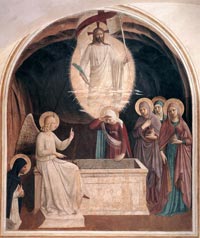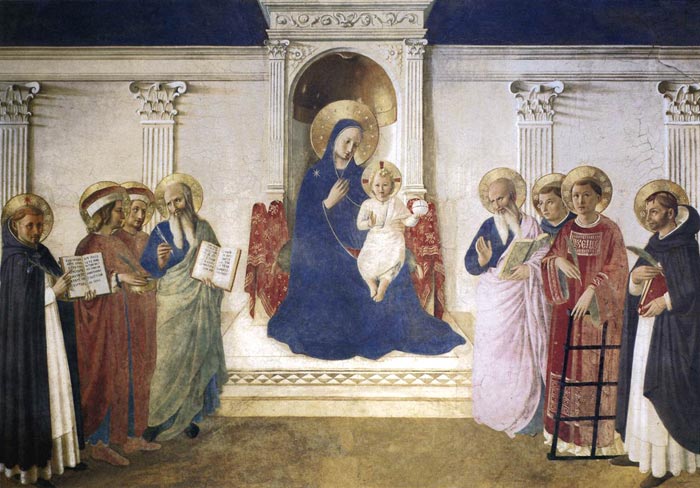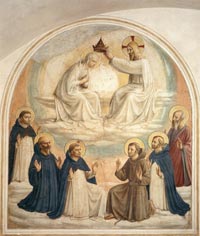 |
||
| I T | Fra Angelico, The Mocking of Christ (detail), with the Virgin and Saint Dominic, 1439-1443, fresco, Cell 7, Convent of San Marco, Florence |
|
Fra Angelico | Frescoes in the Convento di San Marco (1438-50) |
The Museum of San Marco is located in the former monastery of the Dominicans, constructed by Michelozzo in 1436 on a commission from the Medici ruler Cosimo the Elder. Michelozzo here adheres firmly to the Renaissance forms of Brunelleschi, even though his classicism has none of the other's passion for archeological research in it. The smooth, flowing lines of the cloister's arches create effects of light and shade which alternate in the series of vaults. Naturally the religious function and the deliberately spiritual effect of the structure, suggested by the order's Vicar General and perhaps by Fra Angelico himself, qualify these chiaroscuro and plastic impressions. The history of San Marco is inseparably linked to the figures of the painters, Fra Angelico and Fra Bartolommeo, and the friar Girolamo Savonarola.
|
 |
|
In the chapter hall, Fra Angelico executed a large Crucifixion that seems akin to the Moralities of the 14th century, which urged detachment from worldly vanities and salvation through Christ alone. In addition to the three crucified figures against the sky, Angelico painted groups of ritual figures, rhythmically arranged, with a chorus of martyrs, founders of religious orders, hermits, and defenders of the Dominican order (whose genealogical tree is depicted beneath this striking scene), as well as the two Medicean saints. Thus, in the comprehensiveness of this work, Fra Angelico developed a concept that was barely suggested in his earlier altarpieces. |
||||
According to Giorgio Vasari, in the early part of his career, Benozzo Gozzoli was a pupil and assistant of Fra Angelico: some of the works in the convent of San Marco of Florence were executed by Gozzoli from Angelico's design. |
||||
Frescoes in the upper floor cells |
||||
Noli Me Tangere |
||||
 |
||||
Fra Angelico, Noli Me Tangere, 1440-41, fresco, 180 x 146 cm,Convento di San Marco, Florence
|
||||
| Noli me tangere, (meaning "don't touch me"), is the fresco on the wall of Cell 1 of the Convento di San Marco in Florence. The brilliance of the early morning is real enough, but the irradiating light, the floating rather than walking figure of Christ, the wealth of natural detail in the garden, are for devotional reasons and intended to stimulate the meditatin of the monk who lived in the cell. "In this fresco, Christ appears to Mary Magdalene. She has been weeping after discovering that his tomb is empty. A figure appears. At first she mistakes him for a gardener as he is carrying a hoe. Suddenly realizing who it is, she goes to embrace him. But he moves away, telling her not to touch him - literally Noli Me Tangere."[2] This is the fresco on the wall of Cell 1 of the Convento di San Marco in Florence. The brilliance of the early morning is real enough, but the irradiating light, the floating rather than walking figure of Christ, the wealth of natural detail in the garden, are for devotional reasons and intended to stimulate the meditatin of the monk who lived in the cell.
|
||||
The Annunciation |
||||
 |
||||
Fra Angelico, The Annunciation (detail) , late 1430's, Convento di San Marco, Florence
|
||||
| The Annunciation is the fresco at the top of the Dormitory stairs. This is probably the most reproduced of all Fra Angelico's paintings. of the Convento di San Marco in Florence. In one corridor fra Angelico executed an Annunciation that broadened the pattern of his earlier one in Cortona. This fresco is situated on the wall of the southern corridor, on the upper floor in front of the staircase. The inscription on the pavement reads Salve, Mater pietatis / et totius Trinitatis / nobile triclinium / Maria. The architecture reflects Michelozzo's designs. On the left St Peter the Martyr is represented. This is a favourite theme, here simplified. A contribution of Angelico's pupils can be assumed. The composition of this fresco is severe in the extreme. The Virgin inhabits not a house but a cell as Spartan as that in which the fresco is painted, and beyond Gabriel and Mary the eye meets only a plain blank wall. The one piece of decoration, the capital of the column, is deliberately obscured by the wing of the angel. Here and throughout the series the pallet is extremely restrained, as if Angelico thought rich and varied colours were as likely as decoration to distract the friars from spiritual contemplation.
|
 Fra Angelico, Annunciation |
|||
The Transfiguration |
||||
The Transfiguration shows the directness, simplicity and restrained palette typical of these frescoes. Located in a monk's cell at the Convent San' Marco, its apparent purpose is to encourage private devotion. The Transfiguration is the fresco on the wall of Cell 6 of the Convento di San Marco in Florence.
|
||||
The Mocking of Christ |
||||
 |
||||
Fra Angelico, The Mocking of Christ (detail), with the Virgin and Saint Dominic, 1439-1443, fresco, Cell 7, Convent of San Marco, Florence(1439-43)
|
||||
The The Mocking of Christ is the fresco on the wall of Cell 7 of the Convento di San Marco in Florence. |
|
|||
Resurrection of Christ and Women at the Tomb |
||||
 |
||||
Fra Angelico, Resurrection of Christ and Women at the Tomb, detail, (Cell 8), 1440-42, fresco, 181 x 151 cm, Convento di San Marco, Florence
|
||||
| This is the fresco on the wall of Cell 8 of the Convento di San Marco in Florence. On the left, St Dominic in meditation. The three women on the right were painted by Benozzo Gozzoli who that time was an apprentice in the workshop of Fra Angelico. He collaborated in the pictorial decoration of the Dominican convent of San Marco. |
 Fra Angelico, Resurrection of Christ and Women at the Tomb (Cell 8) |
|||
|
||||
| The Coronation of the Virgin is the fresco on the wall of Cell 9 of the Convento di San Marco in Florence. The glory of St Mary, a theme dear to Angelico is acclaimed by six kneeling saints. The saints represented on the lower part are (from the left) St Thomas, St Benedict, St Dominic, St Francis, St Peter the Martyr and St Mark. The fresco probably belongs to the first ones executed in the Convent by Fra Angelico. These six saints can be seen as a token representation of the elect, who surround Christ and the Virgin in heaven in the traditional rendering of this scene. But like so many other figures in the series of San Marco frescoes, they have an air of detachment from the events to which they are nominally witnesses. They hold their hands out in adoration and gaze heavenwards, but none looks directly at the scene of coronation. The Virgin, with her arms folded over her chest, leans forward to receive the crown. She is seated beside Christ, in accordance with the usual composition for this subject. In this series of frescoes at San Marco Angelico has not turned back to medieval prototypes but instead, through economy in the use of figures, restraint in the overt expression of emotion, and austere use of colour, he has created his own meditative images of remarkable force. |
||||
Adoration of the Magi and Man of Sorrows |
||||
 |
||||
Fra Angelico, Adoration of the Magi and Man of Sorrows (Cell 39), 1441-42, fresco, 1175 x 357 cm, Convento di San Marco, Florence
|
||||
| Adoration of the Magi and Man of Sorrows is the fresco on the wall of Cell 39 of the Convento di San Marco in Florence. One cell at the end of the corridor for lay brothers was distinguished by its occupant and size. It was intended for Cosimo de' Medici, who belonged to the community by virtue of his patronage. His room, in fact, was a double cell (Cells 38 and 39), in which the superimposed chambers were joined by a short flight of stairs. Of all the cells along this corridor, Cosimo's was the most spacious and elaborately decorated. On the entrance wall of the lower room (Cell 38) Fra Angelico painted the crucified Christ against a ground of costly lapis lazuli, rather than the bare plaster background found in the other cells. The inscribed haloes identify the saints kneeling alongside the Virgin as Cosmas, Peter martyr and John the Evangelist, protectors of Cosimo, his oldest son, and his father, Giovanni di Bicci. The Adoration of the Magi and the image of Christ as Man of Sorrows in the recessed tabernacle below met Cosimo's gaze once he ascended the stairs to Cell 39. Benozzo Gozzoli, whose style closely resembled that of Angelico, and an assistant painted these frescoes, as shown by the slightly awkward stance and proportions of some of the figures as well as by their linear, closely spaced facial features. |
||||
Frescoes in the corridors and in the Chapter Room of the Convento di San Marco
|
||||
| Sacra Conversazione |
||||
 |
||||
Fra Angelico, Sacra Conversazione, c. 1443, fresco, 195 x 273 cm, Convento di San Marco, Florence
|
||||
The Sacra Conversazione fresco on the wall of the east corridor of the convent is also called Madonna of the Shadows (Madonna delle Ombre).
|
||||
Crucifixion and Saints |
||||
The giant fresco occupies the entire wall opposite to the entrance of the Chapter Room. The saints depicted are, from the left: Cosmas and Damian, Lawrence, Mark the Evangelist, John the Baptist, the Virgin and the pious women; to the right of the Cricifixion kneeling Dominic, Jerome, Francis, Bernard, John Gualberto and Peter the Martyr, standing Zanobi (or perhaps Ambrose), Augustin, Benedict, Romuald and Thomas of Aquino. Around the fresco, on the border, are the busts of the Prophets and Sybils in ten hexagons; in the centre, above the Crucifixion the pelikan, symbol of the redemption. Below, in the lower frieze there are 17 medallions with portraits of the most illustrious members of the Dominican Order.
|
||||
|
||||
 |
||||
Fra Angelico, The Annunciation, c. 1443, fresco, 195 x 273 cm, Convento di San Marco, Florence
|
||||
This fresco is situated on the wall of the northern corridor on the upper floor in front of the staircase in the Convento di San Marco in Florence. It was painted on Angelico's return from Rome in 1450, and is therefore several years later than the majority of the frescoes at San Marco. In style it falls between the sparseness of The Annunciation in cell 3 and the richness of the Cortona altarpiece. Unlike in the Cortona version, the garden is here viewed through a colonnade of columns which recede to a vanishing point near the centre of the painting.
|
||||
Fra Angelico in Palazzo Strozzi en Museo San Marco
The exhibition "Beato Angelico" at Palazzo Strozzi and the Museo San Marco explores the work, development, and influence of Beato Angelico's art, as well as his relationships with painters such as Lorenzo Monaco, Masaccio, Filippo Lippi, and sculptors like Lorenzo Ghiberti, Michelozzo, and Luca della Robbia. It is the first major exhibition in Florence dedicated to the artist exactly seventy years after the 1955 monograph. |
||||
 |
|
 |
||
Palazzo Strozzi, Firenze
|
Beato Angelico, mostra Palazzo Strozzi and Museo di San Marco, Firenze, 2025
|
Museo di San Marco, veduta posteriore
|
||
| |
|
|||
Beato Angelico, veduta della sala nel Museo San Marco, dedicata agli esordi di Angelico e al contesto artistico in cui si formò, Beato Angelico, mostra nel Palazzo Strozzi e Museo di San Marco, Firenze, 2025
|
Beato Angelico, veduta della mostra, sala 8, I Medici, con i pannelli dell'Armadio degli Argenti, e la Pala di Bosco ai Frati , Palazzo Strozzi, Firenze, 2025
|
Allestimenti della mostra Beato Angelico, Biblioteca di Michelozzo, Museo di San Marco, Firenze, 2025
|
||
|
||||
[1] The Theater: The Bearers of Gifts Set down in the chronicle of the San Domenico convent at Fiesole are the simple facts about Fra Angelico: in 1407 "Fr. Joannes Petri de Mugello iuxta Vichium, optimus pictor, qui multas tabulas et parietes in diversis locis pinxit, accepit habitum clericorum in hoc conventu . . . et in sequenti anno fecit professionem."* To this, Vasari adds only that Fra Giovanni's name was Guido, that he was born in 1387, and entered the Dominican monastery "chiefly for the sake of his soul and for his peace of mind." The decision of Fra Angelico and his brother, who became Fra Benedetto, to present themselves at the doors of the small Dominican monastery, set in a vineyard at the foot of the hill of Fiesole outside Florence, came at a crucial time. A wave of reform was sweeping the Dominican monasteries of Italy; revived humanism, based on study of recently rediscovered classic manuscripts, was threatening the church with a new kind of paganism. The new convent of San Domenico, then less than two years in existence, was a spearhead of the reformed order of Dominican Observants. Its leader, the eloquent Fra Dominici, raised up against the New Learning the stern teachings of the church fathers: "Christ is our only guide to happiness . . . our father, our leader, our light, our food, our redemption, our way, our truth, our life." Fra Dominici exhorted the young monks: "As the years of tender youth flow by, the soft wax may take on any form. Stamp on it the impress not of Narcissus, Myrrha, Phaedra or Ganymede, but of the crucified Christ and of the saints." It was to this effort that Fra Angelico, for whom the goal both of life and art was "the contemplation and realization of Beauty," devoted the rest of his life. The Theater: The Bearers of Gifts | www.time.com [2] Nicola Hodge and Libby Anson, The A-Z of Art: The World's Greatest and Most Popular Artists and Their Works, Thunder Bay Press (CA), 1996 |
||||
|
||||
Podere Santa Pia, mystic holiday home in the heart of the Tuscan Maremma
|
Casa Vacanze Podere Santa Pia, Castiglioncello Bandini, Toscane
|
Colline sotto Podere Santa Pia con ampia vista sulla Maremma Grossetana
|
||
| |
|
|||
A beautiful summer morning by the pool
|
Reflections on the private swimming pool at Podere Santa Pia
|
The night pool at Podere Santa Pia exudes a hypnotic sense of purity
|
||
Florence, Santa Croce
|
San Marco, Florence
|
Castiglioncello Bandini
|
||
|
||||
This page incorporates text from the article Angelico, Fra by William Michael Rossetti, in the Encyclopædia Britannica, Eleventh Edition, a publication now in the public domain, and uses material from the Wikipedia articles Fra Angelico and San Marco Altarpiece published under the GNU Free Documentation License. |
||||
|
||||
Vista sulla campagna maremmana, paese etrusco | Impressions and reviews |
||||








